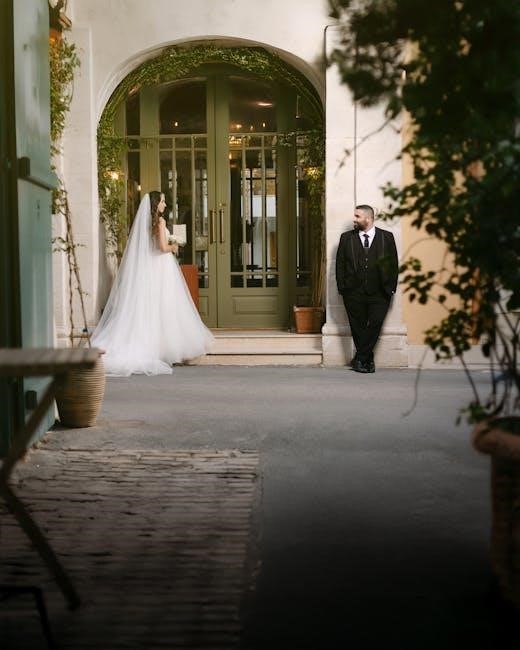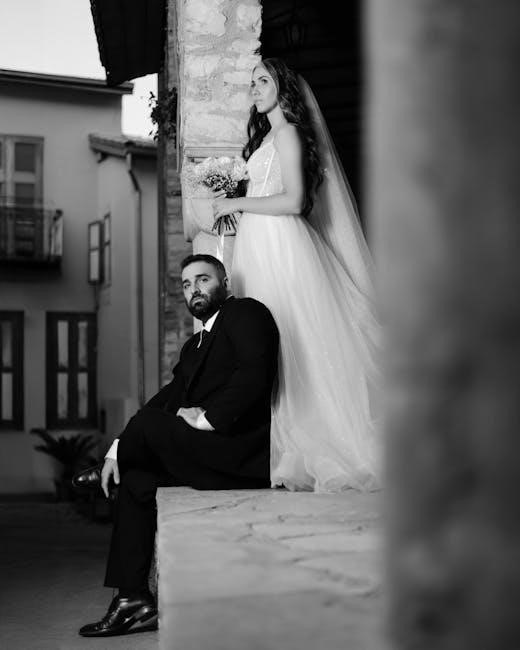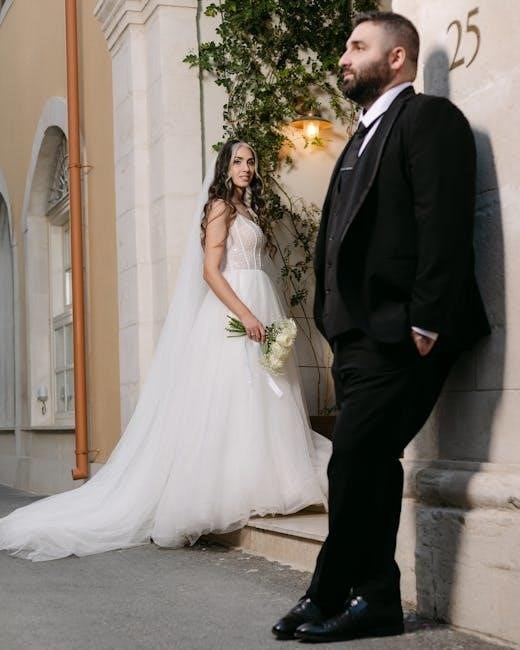Felix Mendelssohn’s Wedding March, from A Midsummer Night’s Dream, is a timeless composition widely used in wedding ceremonies․ Its grandeur and joy resonate universally, making it a popular choice for celebrations․ The piece, originally part of an orchestral suite, has been adapted for various instruments, ensuring its accessibility and enduring appeal․ Today, it remains a cultural icon, symbolizing love and unity, with free sheet music readily available in PDF and MIDI formats for musicians worldwide․
1․1 Historical Context of the Wedding March
Mendelssohn’s Wedding March was composed in 1842 as part of his incidental music for Shakespeare’s A Midsummer Night’s Dream․ Originally written for orchestral performance, the piece was intended to accompany the play’s wedding scene․ The march gained popularity as a wedding processional in the late 19th century, particularly after its use in the 1858 wedding of Princess Victoria, daughter of Queen Victoria․ This association solidified its place in wedding traditions worldwide․ Interestingly, Mendelssohn did not initially intend the piece for actual weddings, but its triumphant and joyful melody made it a natural fit․ Today, it remains a timeless choice for couples, reflecting its enduring cultural appeal․

1․2 Popularity of the Wedding March in Modern Weddings

Mendelssohn’s Wedding March remains a beloved choice for modern weddings due to its timeless elegance and joyful resonance․ Its grand, triumphant melody evokes a sense of romance and celebration, making it a perfect fit for wedding ceremonies․ Many couples opt for the traditional orchestral version, while others prefer modern adaptations, such as piano solos or string quartet arrangements․ The march’s universal appeal lies in its ability to transcend generations, blending tradition with contemporary tastes․ Its association with joy and new beginnings ensures its continued relevance in wedding customs worldwide, solidifying its status as a cultural icon in nuptial celebrations․
Background of Felix Mendelssohn
Felix Mendelssohn, born in 1809 in Hamburg, came from a distinguished family․ A child prodigy, he became a prominent composer and conductor, reviving Bach’s legacy, influencing Romantic music․
2․1 Biography of Felix Mendelssohn
Felix Mendelssohn Bartholdy was born on February 3, 1809, in Hamburg, Germany, to a prominent Jewish banking family․ His early life was marked by prodigious talent, with his first compositions emerging at age 11․ Mendelssohn’s education included rigorous musical training under Carl Friedrich Zelter, fostering his mastery of composition and conducting․ In 1829, he famously revived J․S․ Bach’s St․ Matthew Passion, reintroducing Bach’s music to the public․ Mendelssohn became a leading figure in the Romantic era, known for his lyrical style and deep emotional expression․ His personal life included marriage to Cécile Jeanrenaud, with whom he had five children․ Despite his untimely death in 1847 at 38, Mendelssohn’s legacy endures as a composer, conductor, and revitalizer of classical music traditions;
2․2 Mendelssohn’s Contribution to Classical Music
Felix Mendelssohn significantly influenced classical music as a composer, conductor, and revitalizer of historical works․ His compositions bridged the Classical and Romantic eras, blending elegance with emotional depth․ Mendelssohn’s orchestral works, such as his symphonies and overtures, showcased his mastery of form and orchestration․ He was a pioneer in reviving the music of J․S․ Bach, which had fallen out of favor, and his efforts led to a renewed appreciation for Baroque music․ Mendelssohn also founded the Leipzig Conservatory, fostering musical education and talent․ His lyrical style and innovative use of instrumentation left a lasting impact on classical music, ensuring his legacy as one of the era’s most important figures․
2․3 The Composition of the Wedding March
Felix Mendelssohn composed the Wedding March in 1842 as part of his incidental music for Shakespeare’s A Midsummer Night’s Dream․ Originally titled Ein Sommernachtstraum, the piece was written for a Prussian royal wedding․ The march is characterized by its grand, triumphant melody and rhythmic energy, making it a perfect accompaniment for celebratory occasions․ Its harmonic richness and orchestral texture showcase Mendelssohn’s mastery of classical forms․ Over time, the Wedding March gained global popularity, becoming a staple at wedding ceremonies․ Its widespread use in weddings reflects its timeless appeal and its ability to evoke joy and solemnity simultaneously, solidifying its place in cultural and musical history․
The Wedding March as Part of A Midsummer Night’s Dream
Mendelssohn’s Wedding March was originally composed for Shakespeare’s A Midsummer Night’s Dream, highlighting its theatrical roots and connection to the play’s joyful and celebratory atmosphere․
3․1 The Play and Its Significance
A Midsummer Night’s Dream is a timeless comedy by William Shakespeare, exploring themes of love, magic, and transformation․ Its significance lies in its enduring appeal, blending humor and fantasy to create a universally relatable narrative․ The play’s portrayal of human emotions, intertwined with supernatural elements, has made it a cornerstone of English literature and theater․ Composed in the late 16th century, it remains a celebrated work, often adapted and performed globally․ Mendelssohn’s Wedding March, originally written for the play, reflects its joyful and celebratory essence, further cementing its connection to cultural and artistic heritage․ The play’s influence on music and art underscores its lasting impact on creative expression․
3․2 The Role of the Wedding March in the Suite
The Wedding March is a central piece in Mendelssohn’s incidental music for A Midsummer Night’s Dream, composed in 1843․ It was written to accompany the play’s final act, celebrating the union of Theseus and Hippolyta․ The march is part of a larger suite of 13 movements, each reflecting key scenes from the play․ Its triumphant and joyful melody captures the festive atmosphere of the nuptials, making it a standout piece․ The Wedding March is often performed independently but was originally intended to seamlessly integrate into the theatrical performance․ Its inclusion in the suite underscores Mendelssohn’s ability to marry music with drama, creating a timeless auditory experience that resonates beyond the stage․
3․4 Structure and Musical Elements of the March
Mendelssohn’s Wedding March is structured in a grand, triumphant style, written in the key of C major․ It features a lively tempo in common time, creating a sense of joy and celebration․ The march begins with a dramatic fanfare-like introduction, followed by a lyrical, flowing melody that builds in intensity․ The composition incorporates dynamic contrasts, with crescendos and decrescendos that emphasize the emotional depth․ The orchestration includes brass, strings, and percussion, adding richness and vibrancy․ The march follows a clear ternary form, with an exposition, development, and recapitulation, showcasing Mendelssohn’s mastery of classical musical structure․ Its harmonious blend of melody and rhythm has made it a timeless piece for both weddings and classical performances․

Sheet Music Availability and Formats
Mendelssohn’s Wedding March sheet music is widely available online in PDF, MIDI, and digital formats, offering easy access for musicians and wedding planners alike․
4․1 Free PDF Downloads of the Wedding March
Mendelssohn’s Wedding March is widely available as a free PDF download due to its public domain status․ Many music repositories, such as MuseScore and IMSLP, offer high-quality sheet music for various instruments․ Piano solo versions are particularly popular, but orchestral scores and arrangements for strings or brass are also accessible․ These PDFs are ideal for musicians, wedding planners, and music enthusiasts․ Users can search for “Mendelssohn Wedding March PDF” to find reliable sources․ Ensure the download is from a reputable site to guarantee accuracy and quality․ This accessibility makes the piece a timeless choice for weddings and performances worldwide, maintaining its cultural and historical significance․
4․2 MIDI and Other Digital Formats
Mendelssohn’s Wedding March is also available in MIDI and other digital formats, offering flexibility for musicians and planners․ MIDI files provide a versatile way to customize the piece, as they can be edited using software․ Websites like MuseScore and other digital repositories offer MIDI downloads for free or at minimal cost․ Additionally, formats like MP3 and WAV are popular for direct playback at weddings or events; These digital versions are ideal for couples seeking modern adaptations or for musicians arranging the piece for specific ensembles․ They allow for easy integration into playlists or live performances, ensuring the Wedding March remains accessible and adaptable for contemporary use while preserving its timeless appeal․
4․3 Arrangements for Different Instruments
Mendelssohn’s Wedding March is available in arrangements for various instruments, catering to diverse musical preferences and ensemble needs․ Common arrangements include piano solo, organ, string quartets, brass ensembles, and full orchestral versions․ These adaptations ensure the piece can be performed in different settings, from intimate ceremonies to grand events․ Many websites offer downloadable PDFs of these arrangements, allowing musicians to easily access and print them․ Additionally, some arrangements are tailored for specific skill levels, making the Wedding March accessible to both amateur and professional performers․ This versatility has helped the piece remain a popular choice for weddings and musical performances worldwide․

Instruments and Arrangements
The Wedding March’s adaptability shines through its various arrangements for different instruments and ensembles, ensuring it suits any wedding’s musical style and setting perfectly․
5․1 Original Orchestral Arrangement
Mendelssohn’s Wedding March was originally composed for orchestra, featuring a grand arrangement that includes flutes, oboes, clarinets, trumpets, trombones, and a full string section․ The piece begins with a triumphant fanfare, gradually building into a joyful and celebratory melody․ Timpani and harp add depth and texture, while the brass section underscores the march’s regal and festive character․ This orchestral version remains the most iconic and widely used arrangement, evoking a sense of tradition and splendor․ Its rich instrumentation creates a powerful and emotive sound, making it a popular choice for grand wedding ceremonies․ The original orchestral arrangement is often considered the definitive version, capturing the essence of Mendelssohn’s vision․
5․2 Piano Solo and Duet Arrangements

Mendelssohn’s Wedding March is widely available in piano solo and duet arrangements, offering a more intimate interpretation of the piece․ The solo version captures the melody’s grandeur with intricate harmonies, while the duet arrangement divides the music between two pianists, creating a rich, layered sound․ These formats are ideal for smaller wedding settings or for musicians seeking to perform the march in a more accessible way․ Piano arrangements preserve the original’s emotional depth and celebratory tone, making them a popular choice for both personal enjoyment and ceremonial use․ PDF versions of these arrangements are readily available, providing musicians with convenient access to this timeless piece․
5․3 String Quartet and Chamber Music Versions
Mendelssohn’s Wedding March is beautifully adapted for string quartets and chamber music ensembles, offering a refined and elegant interpretation; These arrangements emphasize the piece’s lyrical qualities, with violins, violas, and cellos blending harmoniously to create a warm, intimate sound․ String quartet versions are particularly popular for weddings, as they provide a balanced and sophisticated accompaniment to the ceremony․ Chamber music arrangements expand on this, incorporating additional instruments for a richer texture․ PDF sheet music for these versions is widely available, allowing musicians to perform the march in various settings․ The string quartet and chamber music adaptations retain the original’s joy and grandeur while offering a more subdued, classical feel․
5․4 Brass and Wind Ensemble Arrangements
Mendelssohn’s Wedding March has been beautifully adapted for brass and wind ensembles, showcasing its triumphant and celebratory nature․ These arrangements often feature bright trumpets, rich trombones, and lush woodwinds, creating a grand and festive atmosphere․ Brass versions highlight the march’s bold and joyful melodies, while wind ensembles add a light, airy texture․ Many PDF sheet music arrangements are available for brass bands, concert bands, and smaller wind groups, making it accessible for various performance settings․ These adaptations are ideal for outdoor weddings, ceremonies in large spaces, or events requiring a more robust sound․ They maintain the original’s emotional depth while offering a fresh, dynamic interpretation․
Performance and Usage in Weddings
The Wedding March is traditionally performed during the bride’s entrance, creating a grand and joyful atmosphere․ It is often played by an organist or orchestra, emphasizing its ceremonial significance․ Couples worldwide use this piece to signify unity and celebration, making it a timeless wedding classic․ Its uplifting melody evokes emotional resonance, ensuring its enduring popularity in wedding ceremonies and receptions alike․
6․1 Traditional Use in Wedding Ceremonies
Mendelssohn’s Wedding March has been a cornerstone of wedding ceremonies for over a century․ Typically played during the bride’s entrance or the recessional, it evokes joy, elegance, and tradition․ Its uplifting melody and triumphant rhythm create a celebratory atmosphere, making it a timeless choice for couples worldwide․ The march is often performed by orchestras, organists, or string ensembles, depending on the venue and preferences․ Its association with weddings began in the 19th century, and it remains a popular selection due to its grandeur and emotional resonance․ The piece’s structure, with its soaring crescendos and delicate harmonies, perfectly complements the solemnity and happiness of the occasion․
6․2 Modern Adaptations and Variations
Mendelssohn’s Wedding March has inspired countless modern adaptations, blending tradition with contemporary styles․ Many artists and composers have reimagined the piece, incorporating elements from jazz, pop, and electronic music․ These variations often feature instrumental solos or fusion with other cultural melodies, making the march versatile for diverse wedding themes․ Digital remixes and orchestral rearrangements are also popular, offering couples unique ways to personalize their ceremony․ Additionally, the march is frequently performed by non-traditional ensembles, such as electric string quartets or brass bands, creating a dynamic and modern sound while retaining its timeless elegance․ These adaptations ensure the Wedding March remains relevant in today’s multicultural and stylistically diverse celebrations․
6․3 Choosing the Right Arrangement for Your Wedding
Choosing the right arrangement of Mendelssohn’s Wedding March for your wedding depends on the event’s style, venue size, and instrumentation․ For intimate gatherings, a piano solo or string quartet version provides elegance without overwhelming the space․ Larger weddings may benefit from a full orchestral arrangement to create a grand atmosphere․ Consider the skill level of the musicians, as some versions require advanced technique․ Additionally, think about personalizing the tempo or key to match your wedding’s unique vibe․ Many PDF sheet music options are available, offering flexibility for different ensembles․ Ensure the arrangement aligns with your wedding’s theme, whether traditional, modern, or whimsical, to make the moment unforgettable․

Legal and Copyright Considerations
Mendelssohn’s Wedding March is in the public domain, meaning its original composition is freely usable without copyright restrictions․ However, specific arrangements or editions may still be copyrighted, requiring permission for use or distribution․ Always verify the source of any PDF or arrangement to ensure compliance with legal requirements․
7․1 Public Domain Status of Mendelssohn’s Works
Felix Mendelssohn’s compositions, including the Wedding March, are in the public domain․ This is because Mendelssohn passed away in 1847, and under copyright laws, works typically enter the public domain 70 years after the composer’s death․ As a result, his music can be freely used, performed, and distributed without obtaining permission or paying royalties․ This public domain status is why the Wedding March is widely available as free sheet music, including PDF downloads; However, specific arrangements or recordings of the piece may still be under copyright, depending on the interpreter or publisher․ Always verify the source to ensure compliance with legal requirements․
7․2 Copyright Issues with Modern Arrangements
While Mendelssohn’s original Wedding March is in the public domain, modern arrangements and adaptations may be protected by copyright․ This means that downloading or using these versions requires permission from the copyright holder․ Many contemporary arrangers, including those offering Mendelssohn Wedding March PDF files, may hold exclusive rights to their interpretations․ Users must verify the legal status of such arrangements before distribution or public performance․ Infringing on these rights can lead to legal consequences․ Therefore, it is essential to opt for public domain versions or seek proper licensing when using modern adaptations of the Wedding March in weddings or other events․
Additionally, some arrangers may release their work under Creative Commons licenses, allowing limited use without infringement․ Always check the terms of use for any downloaded PDF or digital file to ensure compliance with copyright laws․

Cultural and Historical Significance
The Wedding March is a cultural icon, symbolizing celebration and joy globally․ Its timeless melody bridges Romanticism and tradition, reflecting Mendelssohn’s enduring influence on classical music heritage․
8․1 The Wedding March as a Cultural Icon
Mendelssohn’s Wedding March is a cherished cultural icon, symbolizing joy and celebration across generations․ Its grand, triumphant melody evokes powerful emotions, making it a staple in wedding traditions worldwide․ The march is instantly recognizable, often featured in films, commercials, and parodies, ensuring its relevance in popular culture․ This widespread use has cemented its status as a timeless symbol of celebration, bridging cultural and generational gaps․ As a result, Mendelssohn’s Wedding March remains a beloved and enduring piece, continuing to inspire and resonate with people globally․
8․2 Its Role in Wedding Traditions Worldwide
Mendelssohn’s Wedding March has become an integral part of wedding traditions globally, symbolizing joy and celebration․ Its universal appeal transcends cultural boundaries, making it a staple in ceremonies worldwide․ In many Western weddings, the march is played during the recessional, marking the newlyweds’ exit․ In some cultures, it is adapted to blend with local customs, such as incorporating traditional instruments or rhythms․ The piece’s uplifting melody evokes happiness and unity, resonating with couples and guests alike․ Its widespread adoption reflects its ability to connect people across diverse backgrounds, solidifying its place as a timeless wedding tradition․ Its global influence continues to grow, making it a cherished part of wedding celebrations everywhere․
Educational Resources and Tutorials
Discover Mendelssohn’s Wedding March through educational resources, including PDF sheet music downloads and tutorials․ Websites like Musicnotes and SheetMusicPlus offer detailed scores with fingerings and tempo markings․ Piano tutorials on YouTube provide step-by-step guides for learners, while platforms like Piano Marvel offer interactive lessons․ These resources cater to both beginners and advanced musicians, ensuring a comprehensive learning experience․
9․1 Sheet Music for Beginners
For those starting their musical journey, Mendelssohn’s Wedding March is an excellent piece to learn․ Beginner-friendly sheet music is widely available, often simplified to suit novice skill levels․ Many websites offer free PDF downloads of the Wedding March, arranged for instruments like piano, violin, or flute․ These versions frequently include larger note sizes, slower tempos, and reduced complexity to make learning easier․ Additionally, MIDI files can be downloaded to hear the piece at a slower pace, aiding in practice․ Some arrangements also include fingering guides or chord charts, making it accessible for new musicians․ This makes it an ideal choice for students or hobbyists looking to add a classic piece to their repertoire․
9․2 Piano Tutorials and Learning Guides
Learning to play Mendelssohn’s Wedding March on the piano is made easier with a variety of tutorials and guides available online․ Many websites offer step-by-step video tutorials, breaking down the piece into manageable sections for pianists of all skill levels․ Some platforms provide interactive sheet music, allowing users to adjust tempo and practice challenging segments․ Additionally, piano learning apps like Piano Marvel and Synthesia offer interactive lessons tailored to mastering the Wedding March․ Beginners can benefit from simplified arrangements, while advanced players can explore intricate embellishments․ These resources ensure that pianists can confidently perform this iconic piece for weddings or personal enjoyment․
- Video tutorials on YouTube and specialized music sites․
- Interactive tools for tempo control and practice․
- Simplified arrangements for beginners․
- Advanced techniques for experienced pianists․
Mendelssohn’s Wedding March remains a timeless classic, with its PDF versions widely accessible for weddings and performances․ Its enduring appeal ensures its lasting relevance in celebration and music․
10․1 The Enduring Legacy of Mendelssohn’s Wedding March

Mendelssohn’s Wedding March remains one of the most recognizable and beloved pieces in classical music, transcending generations․ Composed in 1842 as part of A Midsummer Night’s Dream, it was initially intended for a play but soon became synonymous with wedding ceremonies․ Its timeless appeal lies in its triumphant and joyful melody, evoking celebration and unity․ The piece has been adapted into countless arrangements, from orchestral to piano solos, ensuring its accessibility and enduring popularity․ Today, it is a staple at weddings worldwide, symbolizing love and commitment․ Its legacy is further cemented by its widespread availability in sheet music formats, including PDFs, making it a cherished choice for couples and musicians alike․
10․2 Final Thoughts on Its Relevance Today

Mendelssohn’s Wedding March remains a timeless and universal symbol of celebration, transcending generations and cultural boundaries․ Its enduring appeal lies in its ability to evoke joy, romance, and tradition, making it a staple in wedding ceremonies worldwide․ The march’s grandeur and elegance continue to inspire modern adaptations, ensuring its relevance in contemporary celebrations․ With its public domain status, the piece is accessible to musicians and couples alike, fostering its widespread use․ As a cultural icon, it bridges the past and present, reminding us of the power of music to unite and celebrate life’s most cherished moments․ Its legacy endures, a testament to Mendelssohn’s genius and the universal language of music․